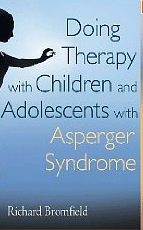Doing Therapy with Children and Adolescents with Asperger Syndrome

“Doing Therapy with Children and Adolescents with Asperger Syndrome”
By Richard Bromfield
John Wiley & Sons, Inc.
Hoboken, N.J. 2010
Use of case material impressive
Reviewed By Paul Efthim, Ph.D.
The blurb on the dust jacket says it all: “This should become the primary text for psychotherapists working with children and adolescents with Asperger’s.”
The blurb writer? No less than Tony Attwood, the renowned authority on the subject.
He’s absolutely correct. Boston-area psychologist Richard Bromfield’s latest book draws on his extensive work in clinics and private practice to offer a supremely accessible yet nuanced guide to therapy with children and teens on the autism spectrum.
What makes this work especially valuable is the liberal use of case material that shows – rather than tells – exactly what Bromfield says and does in the moment-to-moment pick-and-shovel work of therapy. The result is a set of treatment principles that are richly illustrated and thus easily translated into the reader’s own clinical practice.
As Bromfield describes it, “the child with Asperger’s comes into this world neurologically less fit for emotional and social processing and communicating, the primary ingredients for connecting to others – and to oneself.” He refutes outdated notions that these children are unemotional and prefer to be alone, noting how all his patients eventually reveal a deep yearning for connection in spite of their considerable difficulty doing so.
The book passionately argues that a relational approach is ideally suited to the needs of this population. Bromfield articulates a coherent model of therapeutic action worth quoting in its entirety: “We as therapists help the child to contain and bear overwhelming bits of affect, helping them to know and name it and then express it. By repeatedly enabling the child to take those steps, we expand the child’s repertoire of emotional expression, communication and contact. And once the child can make her feelings somehow known to us, we can show our understanding and accepting, which confirms the child’s own feeling state back to herself. I feel this, and it is part of who I am.”
Tailoring his approach to this population, the author counsels that the pace of treatment often needs to be more gradual. The therapist should take care to insulate the child against feelings that can be over stimulating, adopting a quiet curiosity tempered by noninvasiveness and an ability to allow the child to be alone in the presence of the therapist. (Although Bromfield studiously avoids theory and jargon, one can hear strong echoes of Winnicott and Semrad throughout).
Bromfield, who holds a teaching appointment at Harvard Medical School, conveys a deep respect for the diversity and individuality of his patients. He presents several cases of children who began treatment in seemingly hopeless states of withdrawal who were able to use the therapeutic relationship as a vehicle to facilitate tremendous strides in social adaptation.
The book’s 11 chapters are keyed to such prominent Asperger’s themes as sensory issues, anxiety, communication, cognitive style, emotions and depression and social difficulties. A brief appendix offers guidance for work with parents and throughout there are numerous references to other important resources in the field.
Never doctrinaire, Bromfield integrates his perspective with key research findings and emphasizes the importance of a multi-disciplinary approach to treatment, including neuropsychological evaluation, speech and language specialists, medication, social pragmatics, behavior therapies and expressive arts therapies.
This exemplary book is recommended for both novice and experienced therapists working with this challenging yet highly rewarding population.
Paul Efthim, Ph.D. is a licensed psychologist in private practice in Brookline, Mass. and holds a faculty appointment at the Boston Institute for Psychotherapy.
Learn more about the book: Doing Therapy with Children and Adolescents with Asperger Syndrome
